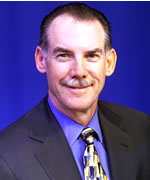 |
Tulane
Engineering Forum
|
|
|
|
|
|
| |
| Opportunities |
| |
| |
| |
| |
Terrence J. McManus, P.E., Terrence J. McManus, Intel Fellow, is Director of Environmental, Health and Safety (EHS) Technologies with focus on Design for the Environment (DfE) within semiconductor packaging and specifically, Intel's current lead-free initiatives. He frequently presents to government officials and the public on the EHS direction and impacts of both Intel and the semiconductor industry. McManus joined Intel in 1983 as the Manager, of Corporate Environmental Affairs, responsible for environmental permitting, pollution prevention and establishment of Intel's worldwide environmental management system. He recently completed a two-year assignment as the EHS Manager for Intel's Assembly and Test Manufacturing operations in China, Costa Rica, Malaysia and the Philippines. Prior to joining Intel, he spent 10 years in environmental consulting. McManus taught at Drexel University, published over 30 articles, and contributed chapters to two handbooks on environmental engineering. In 1995, he was appointed by EPA Administrator, Carol Browner, as member of the Common Sense Initiative Council to represent the electronics industry. He was a consultant (1996 to 1997) to U.S. Environmental Protection Agency's Science Advisory Board contributing to the SAB's publication on integrated environmental decision-making. He recently co-developed with The Nature Conservancy and the US Bureau of Land Management a website to allow 7-8-9 Grade science students to take a virtual tour of two of the 200 "Last Great Places" in the world. For 20 years, he has been a member of The Charles A. and Anne Morrow Lindbergh Foundation Technical Review Panel for grant applications. He is a Member of the American Society of Civil Engineers Book Review Committee and a member of the Board of Directors for The Phoenix Symphony. McManus
holds BS in Civil Engineering
from Union College and MS in
Environmental Engineering from
Cornell University. He is a
registered Civil Engineer in
several states and a Diplomate
in the American Academy of Environmental
Engineers. He is the past chair
of the American Electronic Association's
Environmental and Occupational
Health Committee, past chair
of the American Society of Civil
Engineer's Environmental Engineering
Division and past President
of the American Institute for
Pollution Prevention. He is
listed in both "Who's Who
in Environmental Engineering"
and "Who's Who in Engineering". By
Terrence McManus In 1965, Gordon Moore predicted that the number of transistors in an integrated circuit (IC) per unit of area would double every two years. For the past 35+ years the semiconductor industry has delivered this prediction which has resulted in huge computing capabilities at a very low price. More PC are sold each year in the world then TVs. This increases the demand for electricity. The PC industry has responded to reduce electrical demand from the PC and improved the battery life for laptops while continuing to deliver more power to the user. This presentation will highlight several key accomplishments by the semiconductor industry. |
 |